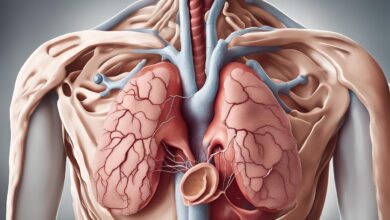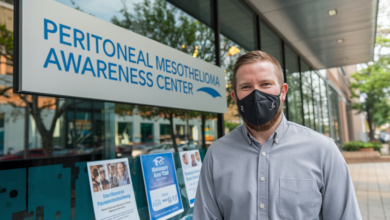Types of Mesothelioma: Pleural Mesothelioma
Unlocking the Mysteries of Pleural Mesothelioma: Your Guide to Diagnosis, Treatment, and Support
1.Introduction to Pleural Mesothelioma
-
Definition and explanation of pleural mesothelioma
Pleural Mesothelioma is a rare and aggressive form of cancer that specifically affects the pleura, the thin membrane surrounding the lungs. This devastating disease is primarily caused by exposure to asbestos, a fibrous mineral that was widely used in various industries. The asbestos fibers, once inhaled, can lodge in the pleura, leading to the development of this malignant condition.
Understanding Pleural Mesothelioma is crucial due to its aggressive nature and the challenges associated with early detection, as its symptoms often mimic those of less severe respiratory conditions. Awareness of the risks and the importance of avoiding asbestos exposure is vital for prevention and improving patient outcomes. This introduction sets the stage for exploring the key aspects of Pleural Mesothelioma, providing a foundation for those seeking information on this serious and often misunderstood disease.

- Importance of understanding this specific type of cancer
Understanding Pleural Mesothelioma is crucial due to its rarity and the specific challenges it presents. This cancer, which affects the lining of the lungs, is primarily caused by asbestos exposure, a factor that distinguishes it from other lung cancers. Awareness of Pleural Mesothelioma is vital because its symptoms often mimic those of less severe respiratory conditions, leading to potential misdiagnosis and delayed treatment. Early detection is paramount for improving prognosis, making it essential for individuals, particularly those with a history of asbestos exposure, to be informed about its signs and symptoms.
Moreover, understanding Pleural Mesothelioma aids in prevention. By recognizing the risks associated with asbestos exposure, individuals can take necessary precautions in both occupational and environmental settings. Additionally, knowledge of this specific cancer type informs tailored treatment approaches, which may differ from those used for other lung cancers. In summary, comprehending Pleural Mesothelioma is key to early detection, effective prevention, and appropriate treatment, thereby enhancing patient outcomes.
2. Causes of Pleural Mesothelioma

Asbestos Exposure: The Primary Cause
Asbestos exposure is the predominant cause of Pleural Mesothelioma, a cancer affecting the lining of the lungs. Asbestos, a naturally occurring mineral, was widely used in various industries due to its strength and resistance to heat and corrosion. However, when asbestos fibers are inhaled, they can become lodged in the lungs, leading to severe health issues over time.
How Asbestos Fibers Lead to Cancer
The mechanism by which asbestos fibers cause cancer involves cellular irritation and DNA damage. When these fibers enter the lungs, they irritate the cells in the pleura, the lung lining. This irritation can lead to changes in the DNA of these cells, resulting in uncontrolled growth and tumor formation. The process is typically slow, with symptoms often appearing decades after initial exposure.
Routes of Exposure: Occupational and Environmental
Exposure to asbestos can occur through various routes. Occupational exposure is common in industries such as construction, mining, firefighting, and shipbuilding, where workers may inhale asbestos fibers in the workplace. Environmental exposure can occur for those living near asbestos mines or factories, or through asbestos-containing products in homes, such as insulation or floor tiles.
Additionally, secondhand exposure is a concern for individuals living with those who work in asbestos-related environments, as fibers can be carried home on clothing or skin.
Other Potential Risk Factors
While asbestos is the primary cause, other potential risk factors for Pleural Mesothelioma exist, though they are less significant. These include exposure to radiation therapy in the chest area, infection with the simian virus SV40, and genetic predispositions. However, these factors are not as strongly linked to the disease as asbestos exposure.
It is also important to note that not everyone exposed to asbestos develops mesothelioma, suggesting that other factors, such as the extent and duration of exposure, and individual genetics, may influence disease development.
3. Symptoms of Pleural Mesothelioma
Pleural Mesothelioma, a rare and aggressive cancer, presents with a variety of symptoms that can be challenging to diagnose in the early stages. Understanding these symptoms is crucial for timely intervention and treatment. This section will explore the common symptoms, less common manifestations, and the challenges associated with early detection due to nonspecific symptoms.
Common Symptoms: Chest Pain, Shortness of Breath, and Coughing
The most frequently reported symptoms of Pleural Mesothelioma include chest pain, shortness of breath, and coughing. Chest pain is often persistent and may worsen with coughing or deep breathing. This pain is due to the tumor’s growth within the pleura, the lining that surrounds the lungs. Shortness of breath occurs as the cancer restricts lung expansion, making it difficult for individuals to breathe comfortably. Coughing, which can be dry or produce mucus, is another common symptom, often exacerbated by the tumor’s impact on lung function.
Less Common Symptoms
In addition to the primary symptoms, patients may experience less common manifestations such as weight loss, fatigue, and difficulty swallowing. Weight loss can occur due to the cancer’s impact on the body’s metabolism, while fatigue may result from the overall strain on the system. Difficulty swallowing, or dysphagia, can occur if the cancer spreads to nearby structures, such as the esophagus. Other less common symptoms might include fever, night sweats, and a general sense of illness.
Challenges in Early Detection Due to Nonspecific Symptoms
One of the significant challenges in diagnosing Pleural Mesothelioma early is the nonspecific nature of its symptoms. Many of these symptoms, such as chest pain and shortness of breath, are similar to those of more common conditions like pneumonia, asthma, or heart disease. This similarity often leads to misdiagnosis or delayed diagnosis, as healthcare providers may initially attribute these symptoms to more prevalent illnesses.
The importance of considering a patient’s history, particularly any history of asbestos exposure, cannot be overstated. Asbestos exposure is the primary risk factor for Pleural Mesothelioma, and recognizing this link is crucial for early detection. Patients and healthcare providers should be vigilant about the possibility of Mesothelioma, especially in those with a known history of asbestos exposure.
In conclusion, while the symptoms of Pleural Mesothelioma can be nonspecific and challenging to diagnose early, awareness and consideration of a patient’s history are key to timely intervention. Regular check-ups and open communication between patients and healthcare providers are essential for improving outcomes in this aggressive cancer.
This section provides a comprehensive overview of the symptoms associated with Pleural Mesothelioma, emphasizing the importance of early detection and awareness.
4. Diagnosis of Pleural Mesothelioma

Diagnostic Process: Imaging Tests (X-rays, CT Scans)
The diagnosis of Pleural Mesothelioma often begins with imaging tests that help identify abnormalities in the pleura, the lining of the lungs. X-rays can reveal pleural thickening or fluid accumulation, which are potential indicators of the disease. However, for a more detailed view, computed tomography (CT) scans are typically used. CT scans provide clearer images of the chest cavity, allowing doctors to detect any irregular growths or changes in the pleura that may suggest Pleural Mesothelioma.
Biopsy Procedures
While imaging tests are crucial, a biopsy is necessary to confirm the presence of cancer cells. There are several types of biopsies used in the diagnosis of Pleural Mesothelioma. A needle biopsy involves inserting a needle through the chest wall to collect a sample of tissue or fluid. In some cases, a surgical biopsy, such as a thoracoscopy, may be performed. This procedure involves inserting a small camera into the chest cavity to visualize and collect tissue samples for analysis.
Newer Diagnostic Methods
Advancements in medical technology have introduced newer diagnostic methods for Pleural Mesothelioma. Positron emission tomography (PET) scans, for instance, can help identify areas of high metabolic activity, which may indicate cancerous growth. Magnetic resonance imaging (MRI) is another tool that provides detailed images of soft tissues, aiding in the diagnosis. Additionally, molecular tests and biomarkers are being explored to enhance the accuracy of diagnosing Pleural Mesothelioma.
Challenges in Diagnosing Due to Rarity and Symptom Similarity
One of the significant challenges in diagnosing Pleural Mesothelioma is its rarity and the similarity of its symptoms to those of other respiratory conditions, such as pneumonia or lung cancer. The nonspecific symptoms, including chest pain, shortness of breath, and coughing, often lead to misdiagnosis. Therefore, it is crucial for healthcare providers to consider a patient’s history of asbestos exposure when evaluating these symptoms. Early diagnosis is vital for effective treatment, and awareness of the risks associated with asbestos exposure can aid in timely intervention.
In conclusion, the diagnosis of Pleural Mesothelioma requires a combination of imaging tests, biopsies, and a thorough understanding of the patient’s medical history. While the process can be challenging due to the disease’s rarity and symptom overlap with other conditions, advances in diagnostic techniques continue to improve detection and outcomes.
5. Treatment Options for Pleural Mesothelioma
Pleural Mesothelioma, a rare and aggressive cancer, requires a comprehensive and often multidisciplinary approach to treatment. The options available include surgery, chemotherapy, radiation therapy, and emerging treatments like immunotherapy. Each treatment modality has its specific role and limitations, and their combination can offer the best outcomes for patients.
Surgery: Types and Purposes
Surgery is a critical component in the treatment of Pleural Mesothelioma, aimed at removing as much of the tumor as possible. The two primary surgical approaches are:
- Pleurectomy: This procedure involves removing the pleura, the lining of the lung, along with any visible tumors. It is often used to relieve symptoms such as chest pain and shortness of breath by reducing the pressure on the lungs.
- Extrapleural Pneumonectomy (EPP): A more radical surgery, EPP involves removing the affected lung, the pleura, and sometimes parts of the diaphragm and heart lining. This is typically reserved for early-stage patients who can tolerate such extensive surgery.
The goal of surgery is not only to remove tumors but also to improve lung function and quality of life.
Chemotherapy: Role and Limitations
Chemotherapy plays a systemic role in treating Pleural Mesothelioma, often used in combination with surgery or radiation therapy. Its primary purposes include shrinking tumors, controlling the spread of cancer, and relieving symptoms. Common chemotherapy drugs used include pemetrexed and cisplatin.
However, chemotherapy has limitations, such as significant side effects and variable effectiveness among patients. Its role is crucial but often palliative, aiming to extend survival and improve quality of life.
Radiation Therapy: Use and Benefits
Radiation therapy is used to target specific areas of the tumor, reducing its size and relieving symptoms like pain. It can be employed before or after surgery, or as a standalone treatment for patients who cannot undergo surgery.
The benefits of radiation therapy include localized tumor control and palliation of symptoms, improving the patient’s comfort and quality of life.
Emerging Treatments: Immunotherapy and Others
Immunotherapy is an emerging treatment option that harnesses the body’s immune system to fight cancer. For Pleural Mesothelioma, immunotherapy drugs like checkpoint inhibitors have shown promise in clinical trials, offering new hope for patients.
Other emerging treatments include targeted therapy, which focuses on specific molecular targets, and participation in clinical trials that explore novel therapies.
Multidisciplinary Approach in Treatment
A multidisciplinary approach is essential for the comprehensive management of Pleural Mesothelioma. This involves a team of specialists, including oncologists, surgeons, radiation therapists, and palliative care experts, working together to tailor treatment plans to individual patient needs.
This collaborative approach ensures that patients receive the most effective and compassionate care, addressing both the physical and emotional aspects of the disease.
In conclusion, the treatment of Pleural Mesothelioma is complex and requires a personalized approach, combining various modalities to achieve the best possible outcomes.
6. Prognosis and Survival Rates

The prognosis for Pleural Mesothelioma, a form of cancer affecting the lining of the lungs, is generally challenging due to its aggressive nature and frequent late-stage diagnosis. Understanding the factors that influence prognosis and the impact of emerging treatments is crucial for patients and healthcare providers alike.
Life Expectancy and Factors Influencing Prognosis
The median survival time for individuals with Pleural Mesothelioma is typically between 12 to 21 months, depending on the treatment received. However, this can vary significantly based on several factors:
- Stage of Cancer: Early detection offers better treatment options, though mesothelioma is often diagnosed at an advanced stage due to its nonspecific symptoms.
- Cell Type: Different cell types within mesothelioma may respond differently to treatments, affecting prognosis.
- Age and Overall Health: Younger patients and those in better general health tend to fare better with treatments.
- Gender: Some studies indicate that women may have a slightly better prognosis than men.
- Tumor Response to Treatment: The effectiveness of chemotherapy or radiation in shrinking tumors can influence survival outcomes.
Improvements in Survival Rates with New Treatments
Advancements in treatment have led to incremental improvements in survival rates. For instance, the combination of pemetrexed and cisplatin or carboplatin chemotherapy has shown efficacy in prolonging survival. Additionally, immunotherapy, particularly PD-L1 inhibitors, has demonstrated promise in enhancing survival for some patients.
Emerging treatments, such as targeted therapies and gene therapy, are currently under investigation in clinical trials, offering potential for further improvements. While overall survival rates have not seen dramatic increases, better treatment combinations and earlier diagnosis in some cases have contributed to modest gains.
Palliative care has also improved, enhancing quality of life and potentially influencing survival by effectively managing symptoms.
The Role of Individualized Treatment Plans and Support Systems
Each patient’s situation is unique, emphasizing the importance of personalized treatment plans. Additionally, support systems play a significant role in a patient’s prognosis, impacting both physical and emotional well-being.
In summary, while Pleural Mesothelioma remains a challenging diagnosis, ongoing research and advancements in treatment offer hope for improved outcomes. Patients are encouraged to consult with their healthcare providers to explore the most appropriate treatment options available.
7. Prevention of Pleural Mesothelioma
Strategies to Prevent Asbestos Exposure
- Use of Personal Protective Equipment (PPE):
- Workers in high-risk occupations should always use appropriate PPE, such as respirators and protective suits, when handling asbestos-containing materials. This reduces the risk of inhaling asbestos fibers, which can lead to Pleural Mesothelioma.
- Safe Handling and Removal of Asbestos Materials:
- Proper protocols for the handling, removal, and disposal of asbestos materials are crucial. trained professionals should conduct these operations to minimize the release of asbestos fibers into the environment.
- Education and Training for Workers:
- Comprehensive training programs should be implemented to educate workers about the dangers of asbestos exposure and the importance of following safety protocols. This includes understanding the signs of asbestos-containing materials and the correct procedures for their management.
- Regular Health Screenings for At-Risk Individuals:
- Regular medical check-ups and screenings can help detect asbestos-related diseases early. This is particularly important for individuals who have been exposed to asbestos in the workplace or environment.
Regulations and Safety Measures in High-Risk Occupations
- Overview of Relevant Laws and Regulations:
- Governments have enacted laws to limit asbestos exposure in the workplace. For example, the Occupational Safety and Health Administration (OSHA) in the United States sets standards for permissible asbestos levels in the workplace.
- Enforcement of Safety Standards:
- Regulatory agencies must enforce these standards rigorously. This includes conducting inspections, issuing citations for violations, and ensuring that employers provide a safe working environment.
- Employer Responsibilities:
- Employers are responsible for providing the necessary training, PPE, and protective measures to their employees. They must also ensure that work environments are regularly tested for asbestos levels.
- Role of Regulatory Agencies:
- Agencies like OSHA and the Environmental Protection Agency (EPA) play a critical role in monitoring and enforcing asbestos safety. They develop and enforce regulations, provide guidelines for safe asbestos management, and conduct research on asbestos-related health risks.
Global Perspective and Advocacy
- The prevention of Pleural Mesothelioma is not limited to individual workplaces or countries. International cooperation is essential in phasing out asbestos use globally. Advocacy for stricter regulations and bans on asbestos can significantly reduce the incidence of this disease worldwide.
In conclusion, preventing Pleural Mesothelioma requires a multi-faceted approach that includes protective measures, education, regulatory compliance, and global advocacy. By implementing these strategies, we can significantly reduce the risk of asbestos exposure and the associated health hazards.
8. Support and Resources
8.1 Support Groups and Counseling Services
Pleural Mesothelioma patients and their families can find solace and support through various organizations and communities. National organizations such as the Mesothelioma Applied Research Foundation and the American Cancer Society offer resources and support networks. Locally, hospitals and community centers often host support groups where individuals can share experiences and coping strategies. Online forums and chat groups provide additional platforms for connection, allowing patients to interact with others facing similar challenges. Mental health support is also crucial, and counseling or therapy services can be invaluable in managing the emotional impact of the disease.
8.2 Financial Assistance Options
Financial burdens often accompany a Pleural Mesothelioma diagnosis, but several options are available to help alleviate these stresses. Government programs, such as those offering financial aid for medical expenses, can provide essential relief. Non-profit organizations like the Cancer Financial Assistance Coalition and the Patient Advocate Foundation also offer grants and assistance to cancer patients. For those seeking compensation due to asbestos exposure, legal resources and the Justice for Victims of Asbestos Act may be relevant. Additionally, patient assistance programs from pharmaceutical companies can help manage the costs of treatment.
8.3 Reliable Information Sources
Access to accurate information is crucial for understanding and managing Pleural Mesothelioma. The National Cancer Institute and the Mayo Clinic are excellent resources for medical information. The Asbestos Disease Awareness Organization provides specialized resources on mesothelioma. For those interested in more in-depth reading, medical journals and books on the subject are recommended. It is also important to evaluate the credibility of online sources, ensuring they are affiliated with reputable medical institutions or organizations.
In conclusion, support and resources are vital for individuals and families affected by Pleural Mesothelioma. Whether seeking emotional support, financial assistance, or reliable information, these resources can provide the necessary help and guidance throughout the journey.
9. Stages of Pleural Mesothelioma
Explanation of Cancer Staging
Cancer staging is a crucial process that describes the extent of cancer in the body and how far it has spread. It helps in determining the most appropriate treatment options and provides insights into the prognosis. For Pleural Mesothelioma, staging is particularly important due to the complexity of the disease.
Staging Systems for Pleural Mesothelioma
Several staging systems have been used for Pleural Mesothelioma, including the TNM system, the Butchart system, and the Brigham system. While the Butchart and Brigham systems were used historically, the TNM system is now the most widely accepted and utilized.
The TNM Staging System
The TNM system categorizes cancer based on three key components:
- T (Tumor): Refers to the size and extent of the primary tumor.
- N (Node): Indicates whether the cancer has spread to nearby lymph nodes.
- M (Metastasis): Shows if the cancer has spread to distant parts of the body.
Stages of Pleural Mesothelioma
- Stage 1:
- The tumor is localized and has not spread to lymph nodes or distant organs.
- Surgical options may be considered to remove the tumor.
- Stage 2:
- The tumor has grown but may still be operable.
- It may have spread to nearby lymph nodes.
- Treatment options include surgery, chemotherapy, and radiation.
- Stage 3:
- The cancer is locally advanced, possibly involving nearby organs or more distant lymph nodes.
- Surgery may be less effective, and treatment may focus on chemotherapy and radiation.
- Stage 4:
- The cancer has widely metastasized to distant parts of the body.
- Treatment is generally palliative, focusing on relieving symptoms and improving quality of life.
Implications of Each Stage
The stage of Pleural Mesothelioma significantly influences treatment options and prognosis. Early stages may offer more aggressive treatment approaches, while advanced stages focus on symptom management and palliative care. Accurate staging is also crucial for eligibility in clinical trials, which may offer experimental treatments.
Challenges in Staging Pleural Mesothelioma
Staging Pleural Mesothelioma can be challenging due to its location and the difficulty in determining the extent of the tumor. Diagnostic tools such as imaging studies and biopsies are essential in accurately staging the disease.
Conclusion
Accurate staging of Pleural Mesothelioma is vital for planning treatment and understanding the disease’s progression. It provides a framework for making informed decisions about the best course of action and predicting outcomes. By understanding the stages, patients and healthcare providers can work together to manage the disease effectively.
10. Emotional and Psychological Impact
Effects on Patients and Their Families
A diagnosis of Pleural Mesothelioma can have profound emotional and psychological effects on both the patient and their loved ones. For the patient, the impact may include:
- Anxiety and Depression: The uncertainty and gravity of the diagnosis can lead to heightened anxiety and depression.
- Fear and Uncertainty: Patients may fear the unknown, including the progression of the disease and the effectiveness of treatments.
- Physical and Emotional Distress: The physical symptoms of the disease, combined with the emotional strain, can significantly affect the patient’s quality of life.
For family members, the emotional burden is equally significant:
- Guilt and Anger: Family members may experience guilt over not being able to prevent the disease or anger at the situation.
- Stress and Financial Burden: The stress of caring for a loved one, combined with potential financial strain from medical expenses, can be overwhelming.
- Shift in Family Dynamics: Roles and responsibilities within the family may shift, leading to tension and emotional strain.
Coping Strategies and Support Available
To manage these challenges, both patients and families can benefit from various coping strategies and support systems:
- Therapy and Counseling: Professional therapy can help address emotional issues and provide coping mechanisms for both patients and families.
- Support Groups: Sharing experiences with others who have faced similar situations can provide comfort and practical advice.
- Educational Resources: Understanding the disease through reliable resources can empower patients and families to make informed decisions.
- Mindfulness and Relaxation Techniques: Practices such as meditation and deep breathing can help manage stress and anxiety.
Open and honest communication within the family and with healthcare providers is crucial for making informed decisions and ensuring emotional support. By acknowledging and addressing these emotional and psychological impacts, patients and their families can better navigate the challenges posed by Pleural Mesothelioma.
Top Mesothelioma Treatment Options in 2025
Exploring Mesothelioma Clinical Trials in 2025
Conclusion
Pleural Mesothelioma is a rare and aggressive cancer primarily caused by asbestos exposure, affecting the lining of the lungs. Understanding this disease is crucial due to its rarity and the challenges it poses in early detection. The symptoms, which often mimic less severe respiratory conditions, can lead to delayed diagnosis, emphasizing the importance of awareness and vigilance, especially in individuals with a history of asbestos exposure.
The diagnostic process involves imaging tests, biopsies, and newer diagnostic methods, each playing a vital role in confirming the presence of cancer. Treatment options range from surgery, chemotherapy, and radiation therapy to emerging therapies like immunotherapy, each offering different benefits and limitations depending on the stage and individual factors.
Comprehensive care for Pleural Mesothelioma extends beyond medical treatments to include emotional and psychological support. Patients and their families benefit from support groups, counseling services, and access to reliable information resources. These elements are crucial in managing the emotional impact of the disease and improving the quality of life for those affected.
In conclusion, early detection and comprehensive care are paramount in improving outcomes for Pleural Mesothelioma patients. Raising awareness about the risks of asbestos exposure, promoting early detection through education, and providing holistic support are essential steps in combating this challenging disease. By focusing on these areas, we can enhance the well-being and prognosis for individuals and families



One Comment